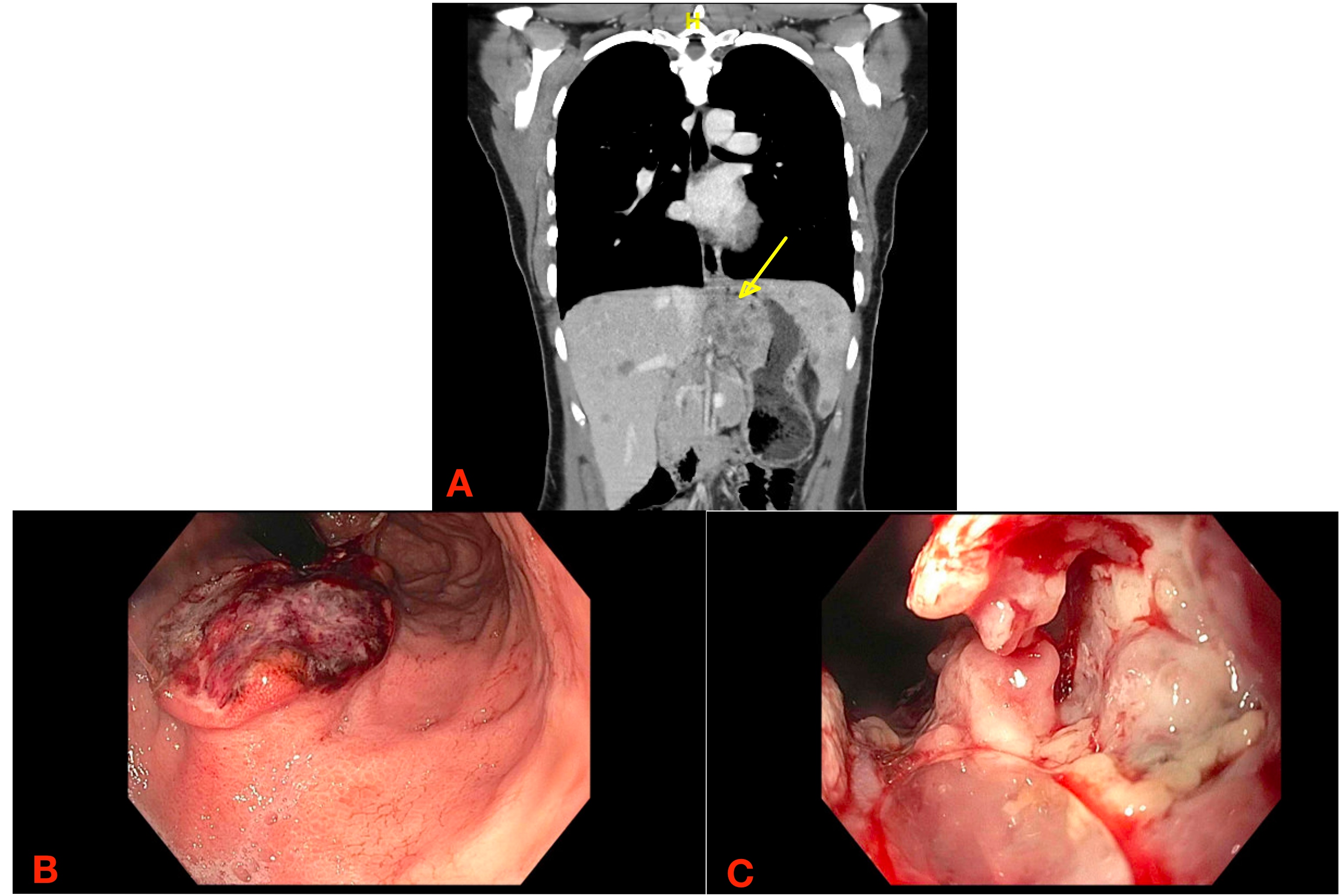Tuesday Poster Session
Category: Esophagus
P5037 - SMARCA4-Deficient Gastroesophageal Carcinoma: A Case Study of a Rare Entity
Tuesday, October 28, 2025
10:30 AM - 4:00 PM PDT
Location: Exhibit Hall

Suvithan Rajadurai, MD
Brown University / Rhode Island Hospital
Providence, RI
Presenting Author(s)
Award: ACG Presidential Poster Award
Suvithan Rajadurai, MD1, Daniel Greenwald, MD2
1Brown University / Rhode Island Hospital, Providence, RI; 2GI Alliance, Providence, RI
Introduction: SMARCA4 is a gene located on chromosome 19p13.2 and encodes for BRG1 protein which regulates gene transcription via alteration of chromatin structure. Loss of function of this gene can lead to SMARCA4-deficient carcinoma, a rare and aggressive malignancy, with less than 40 cases existing in the literature. Notably, the age of these patients has ranged from 45 to 82 years. We present a case here of a 29 year old woman who developed SMARCA4-deficient esophageal cancer and outline points to consider in regards to the diagnosis.
Case Description/
Methods: A 29-year-old female with a past medical history of anxiety and depression presented with severe left upper quadrant abdominal pain alongside six weeks of reflux symptoms, night sweats and an unintentional ten pound weight loss. Her family history was notable for a paternal grandfather with gastric cancer. Computed tomography of the chest, abdomen, and pelvis demonstrated asymmetric soft tissue thickening of the distal esophagus and stomach involving the gastrohepatic ligament alongside extensive liver lesions. Esophagogastroduodenoscopy was performed which demonstrated a large, fungating, infiltrative and ulcerated mass extending from 37-42 cm from the incisors extending along the cardia with oozing of blood. Pathological assessment of the mass revealed SMARCA4-deficient undifferentiated carcinoma. Immunohistochemistry was notable for PD-L1 combined positive score (CPS) of ~5% and claudin positivity. She was treated with two cycles of FOLFOX with the addition of immunotherapy using nivolumab and zolbetuximab. Unfortunately, she developed worsening hepatic and skeletal metastases during cycle two of therapy and died just two months after her diagnosis.
Discussion: SMARCA4-deficient esophageal carcinoma is a recently emerging entity and exceedingly rare, comprising less than 1% of all gastroesophageal carcinomas. As of 2025, there were a total of 32 published cases. This is the first documented case affecting an individual less than 30 years of age. Unfortunately, the average survival following diagnosis is uniformly grim at 2.35 months.There are no chemotherapy regimens demonstrating effectiveness. A few cases have seen some success in treatment with PD-1 inhibitors, however, immunotherapy has only yielded anecdotal evidence. Future research is needed to better understand this class of carcinoma and design treatment options.

Figure: Figure 1. A. CT Chest/Abdomen/Pelvis with yellow arrow demonstrating gastroesophageal mass. B. Mass seen in gastric cardia via EGD. C. Lower third of esophagus showing mass on EGD.
Disclosures:
Suvithan Rajadurai indicated no relevant financial relationships.
Daniel Greenwald indicated no relevant financial relationships.
Suvithan Rajadurai, MD1, Daniel Greenwald, MD2. P5037 - SMARCA4-Deficient Gastroesophageal Carcinoma: A Case Study of a Rare Entity, ACG 2025 Annual Scientific Meeting Abstracts. Phoenix, AZ: American College of Gastroenterology.
Suvithan Rajadurai, MD1, Daniel Greenwald, MD2
1Brown University / Rhode Island Hospital, Providence, RI; 2GI Alliance, Providence, RI
Introduction: SMARCA4 is a gene located on chromosome 19p13.2 and encodes for BRG1 protein which regulates gene transcription via alteration of chromatin structure. Loss of function of this gene can lead to SMARCA4-deficient carcinoma, a rare and aggressive malignancy, with less than 40 cases existing in the literature. Notably, the age of these patients has ranged from 45 to 82 years. We present a case here of a 29 year old woman who developed SMARCA4-deficient esophageal cancer and outline points to consider in regards to the diagnosis.
Case Description/
Methods: A 29-year-old female with a past medical history of anxiety and depression presented with severe left upper quadrant abdominal pain alongside six weeks of reflux symptoms, night sweats and an unintentional ten pound weight loss. Her family history was notable for a paternal grandfather with gastric cancer. Computed tomography of the chest, abdomen, and pelvis demonstrated asymmetric soft tissue thickening of the distal esophagus and stomach involving the gastrohepatic ligament alongside extensive liver lesions. Esophagogastroduodenoscopy was performed which demonstrated a large, fungating, infiltrative and ulcerated mass extending from 37-42 cm from the incisors extending along the cardia with oozing of blood. Pathological assessment of the mass revealed SMARCA4-deficient undifferentiated carcinoma. Immunohistochemistry was notable for PD-L1 combined positive score (CPS) of ~5% and claudin positivity. She was treated with two cycles of FOLFOX with the addition of immunotherapy using nivolumab and zolbetuximab. Unfortunately, she developed worsening hepatic and skeletal metastases during cycle two of therapy and died just two months after her diagnosis.
Discussion: SMARCA4-deficient esophageal carcinoma is a recently emerging entity and exceedingly rare, comprising less than 1% of all gastroesophageal carcinomas. As of 2025, there were a total of 32 published cases. This is the first documented case affecting an individual less than 30 years of age. Unfortunately, the average survival following diagnosis is uniformly grim at 2.35 months.There are no chemotherapy regimens demonstrating effectiveness. A few cases have seen some success in treatment with PD-1 inhibitors, however, immunotherapy has only yielded anecdotal evidence. Future research is needed to better understand this class of carcinoma and design treatment options.

Figure: Figure 1. A. CT Chest/Abdomen/Pelvis with yellow arrow demonstrating gastroesophageal mass. B. Mass seen in gastric cardia via EGD. C. Lower third of esophagus showing mass on EGD.
Disclosures:
Suvithan Rajadurai indicated no relevant financial relationships.
Daniel Greenwald indicated no relevant financial relationships.
Suvithan Rajadurai, MD1, Daniel Greenwald, MD2. P5037 - SMARCA4-Deficient Gastroesophageal Carcinoma: A Case Study of a Rare Entity, ACG 2025 Annual Scientific Meeting Abstracts. Phoenix, AZ: American College of Gastroenterology.

